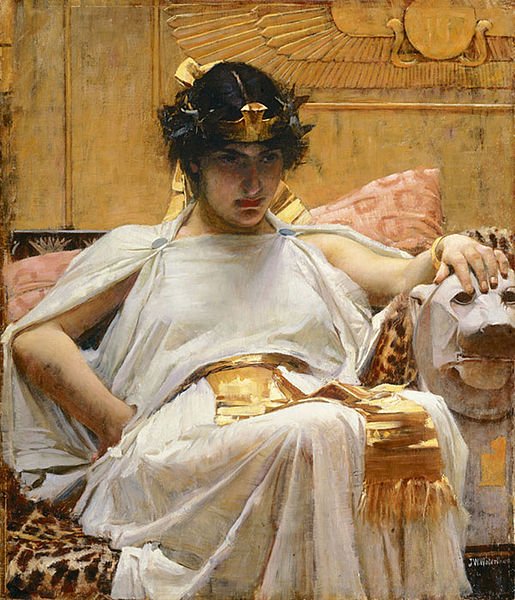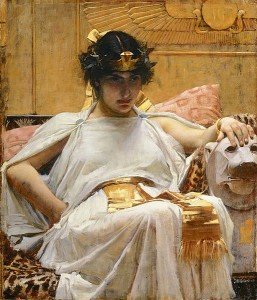Date: 1888
Medium: Oil on canvas
Size: 25.7 x 22.4 in
Location:
Cleopatra's pharaoh
The British painter John William Waterhouse specialized in Greek and Roman history. He was primarily known for scenes from Greek mythology, but also produced portraits of Roman emperors and a variety of other subjects. In his painting of Cleopatra, Waterhouse intertwined her sexy beauty with the splendor and brilliance of Egyptian architecture.
In 44 BC, Cleopatra allied herself with Mark Antony, who was Caesar's legal heir. The two women bore twins – Cleopatra Selene II and Alexander Helios – and one son, Ptolemy Philadelphus. Their relationship continued as they battled the enemies of Egypt. When Cleopatra died of suicide at the Battle of Actium, she stabbed herself in the head with an asp. Caesarion, however, was killed by Octavian on Octavian's orders, and Egypt was soon a Roman province.
Plutarch, a Greek historian, wrote of Cleopatra's intelligence and her love of languages. Though her native language was Koine Greek, she became fluent in nine languages, including Greek. Consequently, she was able to communicate effectively with her armies without the need to translate. Her intelligence and love of languages made her a great leader who could rule without the need for translation.
Waterhouse's early work
John William Waterhouse painted a number of works about the Egyptian Queen Cleopatra, including the portraits of her lover, Mark Antony. In 1872, he also painted the Undine, an ancient Egyptian creature that lived hundreds of years ago. Undines are always portrayed as female, and live in forest pools and waterfalls. They have a beautiful singing voice. Waterhouse painted Cleopatra twice, once in 1894 and again in 1909 or 1910. In the mid-1890s, he also produced a series of portraits for the Artists' War Fund. These works are now in the collection of the composer Lord Lloyd-Webber.
Waterhouse's portraits of Cleopatra are particularly evocative of the myth of the female monarch. The woman portrayed here was once a regal queen of Egypt, but her beauty remains mysterious to this day. While many artists have depicted her as a beautiful, exuberant woman, Waterhouse's depiction differs from most other interpretations. Waterhouse's Cleopatra shows strong facial traits and a fixed gaze.
His models
In this painting by John William Waterhouse, the Egyptian queen is depicted in her beauty and power. Her eyes and body are the most striking feature of the painting, drawing the viewer's attention to her. Waterhouse's use of colors is both sophisticated and evocative. He uses broad strokes to create the texture of the gold, and subtle shading to highlight details of Cleopatra's hair and skin.
The painting is not only stunning, but it is also incredibly controversial. Critics criticized the French influences in the painting. Waterhouse was already approaching the status of the legendary Lourens Alma Tadema. Despite the criticism, it was nonetheless a work of art that was widely admired. The painting is now in the collection of Lord Lloyd Webber. And because it's a masterpiece, it's sure to become a collector's item.
His style
John William Waterhouse and Cleopátra 1888 is a painting that brings new perspective to the iconic Egyptian queen. No other painting of the pharaoh has achieved such an effect. This 1888 painting was Waterhouse's first major commercial success. The painting was exhibited in a gallery at the Society of British Artists. The painting's popularity is undeniable.
Although it is difficult to see Cleopatra's features, her eyes and facial expressions capture the viewer's attention. Waterhouse used a variety of techniques to paint her, including broad, flowing strokes on gold. Her delicate hair and skin are expertly shaded. The belt and wall are filled with glittering gold, and the agitated pose of the Egyptian queen is a key feature of the work.
Although Cleopatra was known to have been a formidable queen of Egypt, she remained mysterious throughout her life. Although many artists portrayed her as a beautiful and flamboyant beauty, Waterhouse's portrayal is more realistic than other representations. Cleopatra tilts her head forward and stares into the distance with a fixed glare.

